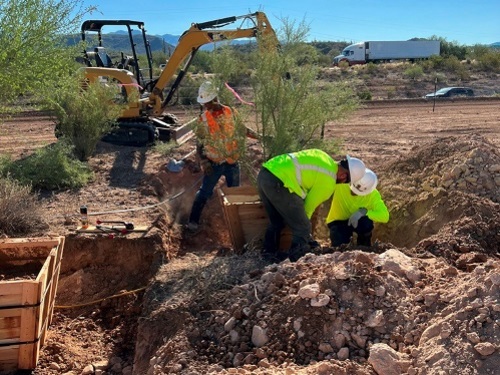As the Arizona Department of Transportation starts work on the I-17 Improvement Project from Anthem Way to Sunset Point, it is taking steps protect the natural landscape along this stretch of scenic highway corridor as well.
[Above photo by the Arizona DOT]
The agency said its work crews are removing native vegetation – including saguaros, palo verde trees and ocotillos – from the 23-mile project corridor to temporary nurseries, before eventually replanting them alongside an improved and wider highway.
Drivers who regularly travel I-17 between Anthem Way and Sunset Point may see some of what the Arizona DOT describes as “plant salvage” work during the next several months. Plant salvage crews from the Kiewit-Fann Joint Venture developer team will collect hundreds of viable native trees, “accents” (such as ocotillos and yuccas), saguaros and other cacti from the construction area. Altogether, roughly two-thirds of the right-of-way along the 23-mile project area will remain undisturbed, meaning no plant salvaging will be necessary.
“October is usually the prime time for salvaging the plant material, just because our temperature is not too hot and not too cold,” said David Casselbury, a landscape architect with Arizona DOT, in a statement. “We’re hoping the general public will enjoy driving along the highway and seeing this plant material back in its natural environment once the project is complete.”
The salvaged trees and cacti are not the only plants returning to the natural landscape once the improvement project is finished, the agency added, as it plans to add native seed mixes and nursery-grown plants to the highway construction area. Those efforts help to achieve the long-term goal of successfully revegetating areas within the construction area considered “landscape-able” with a mix of plants that will thrive and restore the natural environment for years to come.
Restoring native plants has been an integral part of many Arizona DOT projects for more than 35 years, according to the agency.
For example, Arizona DOT spent the last four years relocating a rare and endangered species of cactus growing near the Pinto Creek bridge replacement project along U.S. 60 near Globe-Miami. Initiated in 2018, this relocation effort is the latest step in a long-term partnership between the Arizona DOT and the Desert Botanical Garden in Phoenix to protect hedgehog cactuses that only grow in one tiny area of the state.
The agency also relies on ‘biomonitor’ teams from Northern Arizona University or NAU to help its work crews find and relocate endangered species – including snakes, birds and fish – from construction sites.
Specifically, those biomonitor teams train construction workers and other involved in transportation projects to identify any endangered species and what to do if they come across one. The teams also monitor construction activity and help safely remove any endangered species out of harm’s way.


